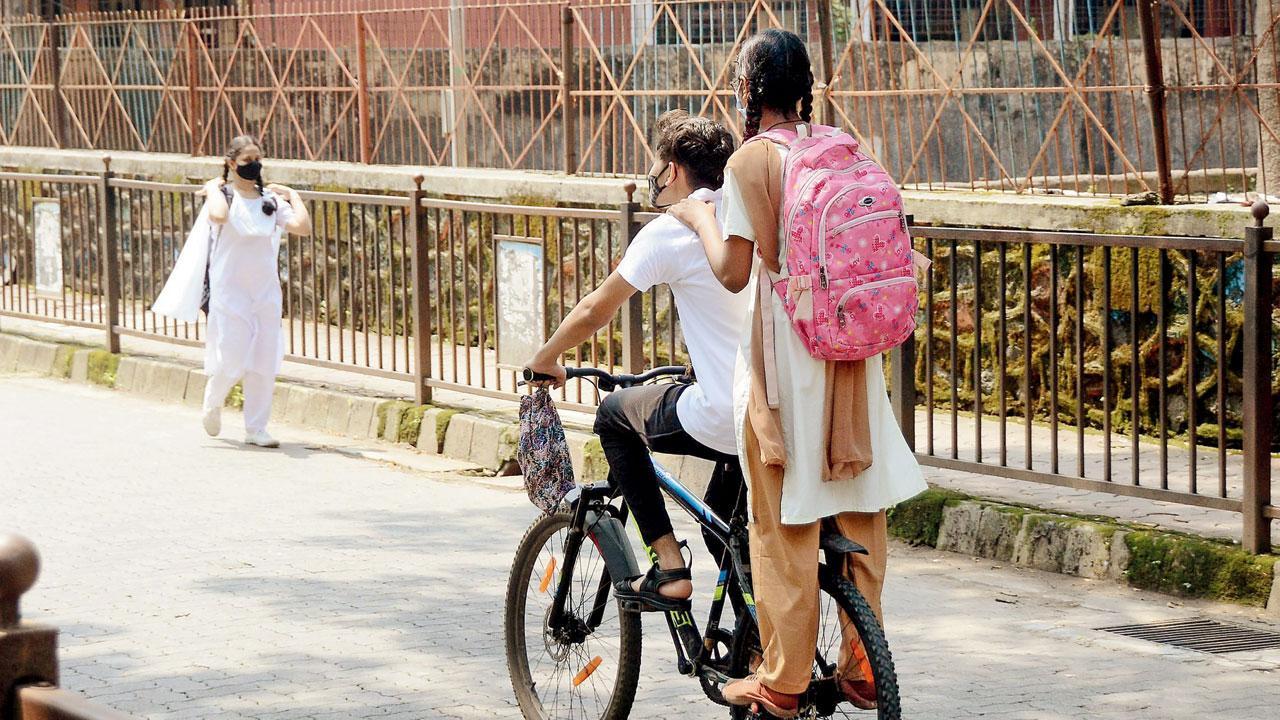Attendance in BMC, smaller schools more than their affluent private peers; schools carve out own models of teaching; in some cases, teachers deliver same lecture multiple times on different forums

Students of Adarsh Vidyalaya, Chembur. Pic/Sayyed Sameer Abedi
Even as schools in Mumbai reopened for offline classes for Std VIII to XII after about 18 months, there is no one model that fits all. Starting from whether to reopen or not and if children should wear uniforms to the design of hybrid teaching to mix online and offline patterns, schools have come up with their individual plans. Also, BMC and smaller schools saw higher attendance than private schools.
ADVERTISEMENT
One fact that stood out on Day 1 was the difference in attendance based on the demographics of students that a school is catering to. Civic schools, government-aided or other small schools offering state board curriculum saw a large number of children for offline classes. But the ones catering to the privileged class had few students walking in. Educationists said this was a rather expected version of the reality, thanks to the digital divide underlined several times all through the pandemic.
“This shows the need for the regular school for students coming from a significant section of society. These students were struggling to meet requirements for online learning and the reopening of schools has really worked well in their favour. Sitting at home of a small room crowded with siblings who are sharing a single device for online school, attending in-person school has been preferred by many,” said Aashirwad Lokhande, principal at Sailee School in Borivali, where two state board schools Marathi and English medium each saw over 30 per cent attendance.
The International school of the same trust has decided to wait for a few more days for reopening on parents’ suggestions. “These children have easy access to online schooling and their parents want to continue in the online mode for some more days before they see how the reopening unfolds,” added Lokhande.
In many schools, the focus on Monday was on helping the students cope with the new life of in-person schooling. At Swami Muktanand High School, Chembur, the attendance was more than 70 per cent. The remaining students, the school said, are out of the city and their parents have agreed to send their wards to school as soon as they are back. Teacher Anil Bornare from the school said, “Many of us only had chats with students to understand how they have been all this time, away from school. Gradually we will start academics too.”
At D S High School in Sion where School Education Minister Varsha Gaikwad visited, the attendance was 95 per cent. “Students were more than happy to be back to school. We have prepared batches of students for different classes to ensure social distancing and also had doctors on campus. We had even kept masks ready for students, but all were well prepared,” shared Rajendra Pradhan, trustee-president. Similarly at G H High School in Borivali, principal Chetna Oza was delighted to see well-disciplined students. “It was a superb experience. Much different from our anticipation on how we will constantly have to keep checking if students are following rules. They are all well aware of the SOPs,” she said, adding that the school saw more than 50 per cent attendance.
With a good attendance record, the hybrid mode of learning is not much of an issue for many schools. However, in several other schools, teachers are toiling to manage online and offline classes together. Some schools have completely different timetables for in-person and online classes, while in many, arrangements are in place to ensure that the teacher delivering a lecture in the actual classroom is visible and audible for online students. In other schools, teachers will have to deliver the same lecture multiple times on different forums or in shifts.
 Subscribe today by clicking the link and stay updated with the latest news!" Click here!
Subscribe today by clicking the link and stay updated with the latest news!" Click here!







